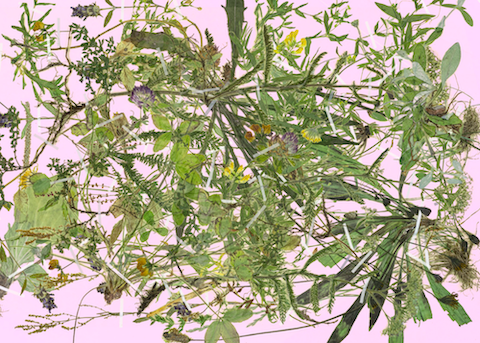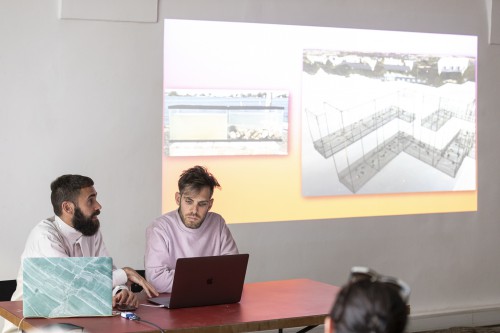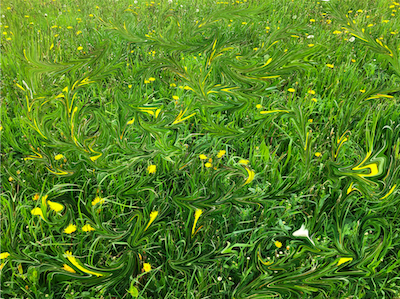FLORAE
09.12.2018 – 15.09.2019
15. September 2019
12:00 Uhr auf der Hagneralm, Welschnofen
FLORAE – Almwiesenverkostung mit COOKING SECTIONS
in Zusammenarbeit mit Transart Festival 2019
Projektpartner:
Hagneralm Welschnofen
Versuchszentrum Laimburg, Labor für Aromen und Metaboliten
Sennereiverband Südtirol
Naturmuseum Südtirol
Eine Almwiesenverkostung auf der Hagneralm (1550m).
Wie schmeckt ein heißer Juni? Wie schlägt sich die Biodiversität einer Wiese, auf der Kühe grasen, auf den Geschmack von Käse nieder? Performativ führt das in London lebende Künstlerduo Cooking Sections mit Käsesommelier, Botaniker, Wissenschaftler durch die Verkostung. Verbindungen zwischen dem Herbarium der Weide und der Käseanalysen aus dem Labor entstehen und öffnen eine Reflektion zum Klimawandel. Der Blumenschmuck, der bei Almabtrieb die Kühe ziert, wird in adaptierter Form von Menschen getragen und ausnahmsweise auf der Alm und nicht im Tal zur Schau gestellt.
Die recherche basierte künstlerische Praxis von Cooking Sections dreht sich um das Essen und die Nahrungskette und wie diese Systeme, Machtverhältnisse und Raumentwicklung beeinflusst. In ihren Installationen, Performances, Videos erforschen die Künstler die Überlappungen von visueller Kunst, Architektur und Geopolitik. Cooking Sections hat unter anderem an der Manifesta 12 (2018) in Palermo, bei documenta 13 (2017) in Kassel und bei der Biennale 2014 in Venedig teilgenommen.
BAU: FLORAE, das am 15. September auf der Hagneralm bei Welschnofen präsentiert wird, bezeichnet ihr als “Almwiesenverkostung”. Warum habt ihr Euch für die Auseinandersetzung mit der Käseproduktion in Südtirol entschieden?
CS: FLORAE ist aus unserem Interesse an der Erhaltung der Alpenflora und der Rolle der Kuh in Südtirol entstanden. Nicht nur als Nutztier, über das eine bestimmte traditionelle Haltungspraxis aufrecht erhalten wird, sondern auch als Tier, das eine bedeutende kulturelle Rolle in der Region spielt. Weidende Kühe auf einer Alm sind ein Schlüsselbild und von zentraler Bedeutung für die lokale Tourismuswirtschaft. Wir sehen die historische Praxis, jedes Jahr eine kleine Gruppe von Kühen auf eine höher gelegene Alm zu bringen, als Möglichkeit, das Bewusstsein für die Bodenökologie zu schärfen. Mit unserem Projekt beobachten wir die von Menschen verursachten Umweltveränderungen in der Region und die Art und Weise, wie Käse aus Wildblumen und Gräsern von Almen zu deren Schutz und Erhalt beitragen könnte.
BAU: Was werden die Teilnehmer von FLORAE erleben?
Das teilnehmende Publikum besucht die Hagneralm und nimmt an einer geführten Verkostung des in Zusammenarbeit mit Johann Kafmann entstandenen FLORAE-Käses teil. Er hat diesen Käse über den Sommer aus der Milch von Kühen produziert, die nur auf der Alm gegrast haben. Ausgehend von diesem Käse und seine Aromen von Blumen und Gräsern, die von der Kuh gefressen und die über die Milch in den Käse übergegangen sind, werden wir die Veränderungen der Landschaft und der Umwelt in Südtirol und den Alpen mit eingeladenen Expertinnen wie einem Botanikern, einer Chemikerin, einer Tierärztin diskutieren.
BAU: Ihr bezeichnet Euch als “spatial practitioners”, Euer Hintergrund sind Architektur und Performancekunst. Eure Projekte als Cooking Sections sind eher forschungsorientiert und ihr arbeitet dabei interdisziplinär zusammen mit Experteninnen, Wissenschaftlerinnen, hier in Südtirol mit Käsern und Botanikern. Wie aber unterscheidet sich diese künstlerische von wissenschaftlicher Forschungsarbeit?
CS: Die Gegenwart konfrontiert uns mit sehr komplexen ökologischen, politischen und sozialen Fragen, die unserer Meinung nach von verschiedenen Personen, Fachleuten und Institutionen mit unterschiedlichem Hintergrund diskutiert werden müssen. Und darum denken wir eben auch, dass es wichtig ist, neue Plattformen für diesen Diskurs zu schaffen. Dazu müssen wir oft mit Menschen aus verschiedenen Disziplinen mit unterschiedlichen Kompetenzen zusammenarbeiten. Für FLORAE, eine Käsekreation mit den Kräutern einer Almwiese war es wichtig das Wissen von Bauern, Chemikern, Bioingenieuren und Botanikern zu bündeln.
BAU: Euer langfristiges Projekt CLIMAVORE paraphrasiert ihr mit den Worten “Jahreszeiten der Nahrungsmittelproduktion und ihres Konsums zu ersinnen, die auf anthropogene Veränderungen von Klima und Landschaften reagieren”. Wie steht das in Zusammenhang mit Eurem Projekt hier in Südtirol?
CS: CLIMAVORE stellt die Frage, wie wir essen, wenn der Mensch das Klima verändert. Das ist ein langfristiges Projekt, das sich mit Szenarien neuer Jahreszeiten beschäftigt, die Faktoren wie Dürren, verschmutzte Ozeane, Bodenerschöpfung und steigende Temperaturen berücksichtig. Diese Phänomene werden durch menschliches Handeln hervorgerufen und es ist notwendig zu überlegen, wie man Ernährung künftig nach ihnen ausrichtet, und nicht nach den vier eurozentrischen Jahreszeiten Sommer, Herbst, Winter und Frühling. Im Zusammenhang mit Südtirol ist es für uns interessant zu beobachten, wie sich Erwärmung, intensive Landwirtschaft, Düngung und Pestizideinsatz auf die Almen und damit auf den Käse auswirken. Käse dokumentiert das Vorhandensein oder Fehlen von Düngung der Wiesen, auf denen die Kühe grasen. Darum streben wir an einen Käse mit der Milch von Kühen herzustellen, die im Gebirge frei grasen, um Monokultur und intensive Landwirtschaft in Frage zu stellen und gleichzeitig die botanische Vielfalt der Wiesen sichtbar zu machen.
14. Mai 2019
18:00 Uhr
ARTIST TALK mit COOKING SECTIONS
CLIMAVORE: What Is Above Is What Is Below, Künstlergespräch mit Cooking Sections, kuratiert von BAU
19:30 Uhr
Das Künstlergespräch wird in Zusammenarbeit mit der Fakultät für Design und Künste der Freien Universität Bozen realisiert.
special thanks to :
Annemarie Kaser, Andreas Österreicher, Bertram Stecher – Sennereiverband Südtirol
Daniela Eisenstecken und Giulia Chitarrini – Versuchszentrum Laimburg, Labor für Aromen und Metaboliten
Thomas Wilhalm – Naturmuseum Südtirol
Sieglinde Nischler – Käsesommelière
Marianna Frena – Tierärztin
Mit freundlicher Unterstützung von: Autonome Provinz Bozen Südtirol, Deutsche Kultur
FLORAE
09.12.2018 – 15.09.2019
15. September 2019
12pm at Hagneralm, Welschnofen
FLORAE – Alpine Meadow Tasting with COOKING SECTIONS
in collaboration with Transart Festival 2019
Project Partner:
Malga Hagner
Laimburg Research Center, Laboratory for Flavour and Metabolites
South Tyrol Diary Association
Museum of Nature South Tyrol
A tasting on the alpine meadows of Malga Hagner (1550m).
What does a torrid June taste look like? How does the biodiversity of a meadow affect a grazing cow, and therefore the taste of cheese? The London-based Cooking Sections launches a performance/tasting with cheese experts, botanists and scientists. To make us reflect on climate change they will research the relationships between the variety of grasses from the meadows and the analysis of the cheese from the laboratories. The floral decorations adorning the cows during the transhumance will be adapted and carried by human beings, and this time around will take place in the chalet instead of the valley.
Cooking Sections was created to investigate the systems that organise the world through food. Using installation, performance, mapping and video, their research-based practice explores the overlapping boundaries between visual art, architecture and geopolitics. Cooking Sections have presented work at Manifesta12 (2018) in Palermo, documenta13 (2017) in Kassel, the 14th Venice Architecture Biennale (2014) and elsewhere.
BAU: FLORAE, that will be presented on September 15th on the Hagneralm close to Welschnofen, is being described as a tasting of an alpine meadow? Could you briefly tell us why you decided to work with the cheese production in South Tyrol?
CS: FLORAE evolved out of our interest in the preservation of the Alpine flora and the role of the Alpine cow in South Tyrol. Not only as a domesticated animal that maintains a specific husbandry practice, but also an animal that has a significant cultural role in the region. Grazing alpine cows are key to preserve the popular image of the alpine meadow and the local tourist and hiking economies. We see the historic practice of bringing a small group of cows every year up to the alm in the high mountain as a way to raise awareness on the ecology of the soil. The project observes the man-made environmental transformations that are occurring in the region and the ways in which cheese made out of wild flowers and grasses in the alm could help preserve alpine meadows.
BAU: What will the participants of FLORAE experience?
CS: Participants will visit the Hagneralm and be part of a guided tasting of the FLORAE cheese created in collaboration with Johann Kafmann. He has made it over the summer from cows that have only grazed in the pasture. Through the cheese, and the flavours of the flowers and grasses eaten by the cow passed on to the milk and cheese, we will discuss the changes to the landscape and the environment in South Tyrol and the Alps.
BAU: You define yourself as spatial practitioners and have a background in architecture and performance art. You’re practice in Cooking Sections is rather research oriented and you often involve experts from different disciplines from scientists to cooks and in our case also cheesemakers and botanists. Where lies for you the difference between a scientific researcher /spatial practitioner /artist as researcher, maybe you can describe this on the example of FLORAE?
CS: We live in a current climate that confronts us with very complex environmental, political and social questions. These are questions we think need to be addressed and discussed by various people, professionals and institutions alike with different backgrounds. That is why we believe it is important to bring forward urgent questions by creating new platform for them to be debated and addressed. For that we often need to collaborate with people from various disciplines with different forms of expertise. In the case of FLORAE, the new cheese produced with alpine meadow plants required to bring together the knowledge of farmers, chemists, bioengineers, and botanists, among others.
BAU: You are exploring systems that organise the world through food. Your long-term project CLIMAVORE in your own words “sets out to envision seasons of food production and consumption that react to man-induced climatic events and landscape alterations”. What does CLIMAVORE stand for and how would you situate FLORAE in this context?
CS: CLIMAVORE questions how we eat as humans change climate. It is a long term project that develops attempts to envision seasons of food production and consumption which respond to drought, polluted oceans, soil exhaustion and increased temperatures to name a few. These phenomena are induced by human actions and it is our role to think how do we eat according to them rather than to the four Eurocentric seasons of summer, autumn, winter and spring. In the context of South Tyrol it is interesting for us to observe how warming temperatures, intensive agriculture; the use of fertilizers and pesticides are all affecting the alpine meadows, and hence the cheese. Cheese in a way records that change in the presence or absence of rich compounds according to what cows graze. That is why we see the potential of producing a cheese from cows that graze freely in the high mountain as a way to limit monoculture and intensive agricultural practices, while paying attention to the polycultures of the meadow.
14 May 2019
6pm
ARTIST TALK with COOKING SECTIONS
CLIMAVORE: What Is Above Is What Is Below, Artist Talk with Cooking Sections, curated by BAU
at The Free University of Bolzano, room C0.04
The artist talk has been organised in collaboration with the Faculty of Design and Art at the Free University of Bolzano.
special thanks to :
Annemarie Kaser, Andreas Österreicher, Bertram Stecher – South Tyrol Diary Association
Daniela Eisenstecken und Giulia Chitarrini – Laimburg Research Center, Laboratory for Flavour and Metabolites
Thomas Wilhalm – Museum of Nature South Tyrol
Sieglinde Nischler – cheese sommelière
Marianna Frena – veterinary
Supported by: Provincia Autonoma di Bolzano Alto Adige
FLORAE
09.12.2018 – 15.09.2019
15. September 2019
ore 12 sulla Hagneralm, Nova Levante
FLORAE – degustazione del pascolo con COOKING SECTIONS
in collaborazione con Transart Festival 2019
Project Partner:
Malga Hagner
Centro di Sperimentazione Laimburg, laboratorio per aromi e metaboliti
Federazione Latterie Alto Adige
Museo di Scienze Naturali dell’Alto Adige
Una degustazione sui prati alpini di Malga Hagner (1550m).
Che sapore ha un torrido mese di giugno? Come si ripercuote la biodiversità di un prato su una mucca che pascola, e dunque sul sapore del formaggio? Il duo londinese Cooking Sections intavola una performance/degustazione in compagnia di esperti di formaggio, botanici e scienziati. Verranno ricercate le relazioni tra la varietà delle erbe che compongono i prati e l’analisi del formaggio proveniente dai laboratori, aprendo così una riflessione sui cambiamenti climatici. Le decorazioni floreali che adornano le mucche durante la transumanza verranno adattate e portate da esseri umani, e in via eccezionale verranno esposte in malga e non in valle.
Il lavoro di Cooking Sections (Daniel Fernández Pascual e Alon Schwabe, Londra) esamina le relazioni tra cibo e catena alimentare, e il mutamento delle stesse nel contesto dei cambiamenti climatici. Uno degli obiettivi della loro pratica è far emergere i sistemi attraverso cui il mondo è organizzato. Nelle loro installazioni, performance e video, gli artisti li esplorano all’intersezione di arte visiva, architettura e geopolitica. Tra le partecipazioni di Cooking Sections ci sono Manifesta 12 (2018) a Palermo, a documenta 13 (2017) di Kassel, e alla Biennale di Venezia 2014.
BAU: FLORAE, che sarà presentato il 15 settembre presso la Malga Hagner nei pressi di Nova Levante, è stato descritto come la degustazione di un prato alpino. Potreste spiegarci perchè in Alto Adige avete deciso di lavorare con la produzione di formaggio?
CS: FLOREA si è sviluppato dal nostro interesse per la conservazione della flora alpina e dal ruolo della mucca grigio alpina in Alto Adige. Non solo in qualità di animale addomesticato e legato a una precisa pratica di allevamento, ma anche in quanto animale che ha un significativo ruolo culturale nella regione. L’iconografia della mucca al pascolo è infatti chiave nella conservazione dell’immagine popolare del prato alpino e dell’economia locale legata al turismo e all’escursionismo. Consideriamo la tradizionale pratica dell’ alpeggio in alta montagna come un modo per portare consapevolezza dell’ecologia del suolo. Il progetto osserva le trasformazioni antropiche dell’ambiente che stanno verificandosi nella regione, ed esplora il modo in cui il formaggio d’alpeggio prodotto da erbe e fiori selvatici possa supportare la conservazione dei pascoli alpini.
BAU: Quale tipo di esperienza accoglierà i partecipanti di FLORAE?
CS: I partecipanti visiteranno la malga Hagner e saranno invitati a una degustazione guidata del formaggio FLOREA, prodotto in collaborazione con Johann Kafmann. Il formaggio è stato prodotto durante la scorsa estate dal latte di mucche nutrite esclusivamente con erba del pascolo. Attraverso il formaggio e i sapori dei fiori e delle erbe che la mucca ha trasmesso al latte di cui è prodotto, discuteremo i cambiamenti ambientali e del paesaggio in Alto Adige e nelle Alpi.
BAU: Vi definite ‘spatial practitioners’ (letteralmente, praticato dello spazio) e avete una formazione in architettura e performance. La vostra pratica artistica come Cooking Sections è orientata alla ricerca e spesso coinvolgete esperti di diverse discipline, da scienziati a cuochi, nel nostro caso da produttori di formaggio e botanici. Qual’è la differenza tra uno scienziato/uno spatial practitioner/un artista come ricercatore? Forse potete provare a descrivercelo con un esempio tratto da FLOREA?
CS: Stiamo vivendo in circostanze che ci pongono di fronte a domande estremamente complesse su temi ambientali, politici e sociali. Sono domande che pensiamo debbano essere affrontate da persone, professionisti e istituzioni con formazione diverse. Crediamo sia importante portare in primo piano questioni urgenti creando piattaforme affinché possano essere affrontate e diventare oggetto di dibattito. Questa è la ragione per cui spesso sentiamo la necessità di collaborare con persone provenienti da diverse discipline e con diverse forme di expertise. Nel caso di FLOREA, la produzione di nuovo formaggio prodotto con piante di pascolo alpino ci ha richiesto di riunire il sapere di contadini, chimici, bio-ingegneri e botanici, tra gli altri.
BAU: State esplorando sistemi che organizzano il mondo attraverso il cibo. Il vostro progetto a lungo termine CLIMAVORE – riportando quanto avete affermato in merito ad esso- “si propone di immaginare stagioni di produzione e consumo di cibo che reagisca agli eventi climatici e alle alterazioni del paesaggio indotti dall’uomo.” Cosa significa il termine CLIMAVORE e come posizionate FLOREA in relazione ad esso?
CS: CLIMAVORE interroga il modo in cui quello che mangiamo in qualità di esseri umani influenza il cambiamento climatico. È un progetto a lungo termine, che sviluppa tentativi di immaginare stagioni di produzioni e consumo di cibo che rispondano a siccità, inquinamento oceanico, esaurimento del suolo e aumento delle temperature – solo per fare qualche esempio. Questi fenomeni son indotti da azioni umane ed è nostro compito pensare come nutrirci in queste condizioni, piuttosto che rimanere ancorati all’eurocentrica successione delle quattro stagioni. In Alto Adige, siamo interessati ad osservare gli effetti sui pascoli alpini e, di conseguenza, sul formaggio prodotti dall’aumento della temperatura, dall’agricoltura intensiva e dall’uso di fertilizzanti e pesticidi. In un certo senso, il formaggio registra i cambiamenti nella densità di certe sostanze in relazione a quello che le mucche brucano. Questa è la ragione per cui vediamo del potenziale nella produzione di formaggio da mucche che pascolano liberamente sulle montagne, con lo scopo di limitare la monocoltura e le pratiche di agricoltura intensiva, prestando attenzione alla pollicoltura dei pascoli.
14 maggio 2019
ore 18:00
ARTIST TALK con COOKING SECTIONS
CLIMAVORE: What Is Above Is What Is Below.
Artist Talk con Cooking Sections, a cure di BAU
alla Libera Università di Bolzano, aula C0.04
La conversazione è realizzata in collaborazione con la Facoltà di Design e Arte della Libera Università di Bolzano.
special thanks to :
Annemarie Kaser, Andreas Österreicher, Bertram Stecher – Federazione Latterie Alto Adige
Daniela Eisenstecken und Giulia Chitarrini – Centro di Sperimentazione Laimburg, laboratorio per aromi e metaboliti
Thomas Wilhalm – Museo di Scienze Naturali dell’Alto Adige
Sieglinde Nischler – sommelière di formaggi
Marianna Frena – veterinaria
Con il gentile supporto di: Provincia Autonoma di Bolzano Alto Adige





